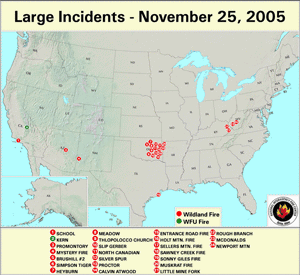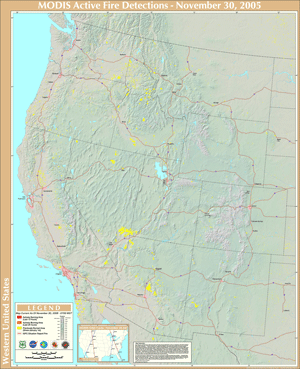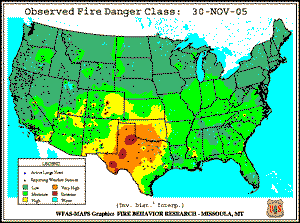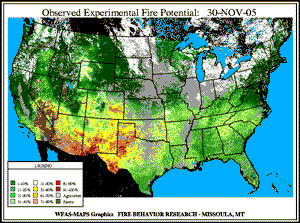Wildfire activity re–intensified across parts of the U.S. during late November, as numerous large fires developed in Oklahoma, Kentucky, Virginia, West Virginia and the Southwest U.S. Many of these fires continued to burn into early December.
Preliminary estimates from the National Interagency Fire Center suggest that this year will break the record set in 2000 for acreage burned, with over 8.5 million acres consumed across the U.S. by early December. During the 2000 fire season over 8.43 million acres were consumed across the entire U.S., with over 7 million acres burned in the contiguous U.S. As of December 9th over 4.14 million acres had burned across the lower 48 states, which was significantly less than in 2000.
Alaska had its second consecutive year with widespread wildfire activity, as over 4.4 million acres burned this year across the state.
The total number of fires across the U.S. continued to decline in 2005, which combined with the increase in acreage suggests that the average size of individual fires has increased over the past 20 years.
| As of December 9, 2005 | Nationwide Number of Fires | Nationwide Number of Acres Burned |
|---|---|---|
| 2005 | 63,529 | 8,581,752 |
| 2004 | 77,534 | 6,790,692 |
| 2003 | 63,269 | 3,959,223 |
| 8–year Average | 68,981 | 5,359,935 |
Dead fuel moisture levels across the western U.S. and High Plains slowly increased during November. In particular, fine fuel moisture levels (i.e., 10–hour fuels) increased above 10% across most western states during the past month, with the exception of the southern Plains.
Medium to larger fuels (i.e., the 30 November 100–hr and 30 November 1000–hr fuel moistures) remained moderately dry at the end of November, especially across the Southwest and Great Basin areas.
The Keetch–Byram Drought Index (KBDI), a widely used index for fire risk, had the largest potential for wildland fire activity in the contiguous U.S. across parts of northern and central California and parts of the southern Plains at the end of November.
For further information on drought conditions across the U.S. go to the November drought summary page.
 NOAA's National Centers for Environmental Information
NOAA's National Centers for Environmental Information



